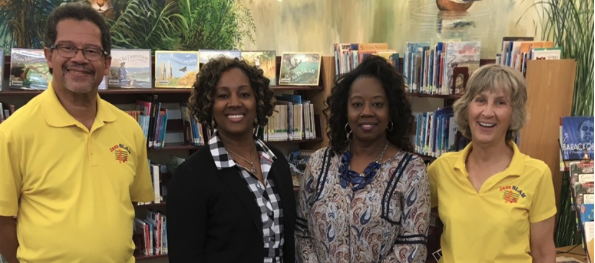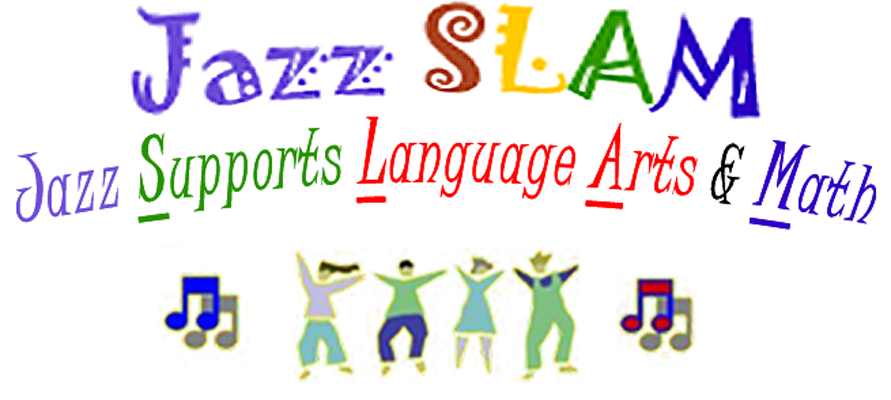JazzSLAM supports teachers’ efforts to raise student standardized test scores by teaching academics through the Aural, Visual, & Tactile (multiple intelligence) benefits of Music. Students participate in a “Rhythm Orchestra” and come to new understandings of Math- fractions and percentages through subdivisions of a whole (note) as they clap, stomp, sing and dance with the intergenerational, multicultural jazz quartet. Your students soar out of their everyday world into a swinging world of pulsating rhythms and melodies.
From simple field hollers to 12 bar blues and AABA song form, JazzSLAM helps students understand the magical mysteries of the structures of songs, melodic contours, poetry/word families in lyrics, and parallel Essay Writing Forms. Students view migration, geography, and American history through the lens of jazz; they learn how African rhythms migrated throughout the Caribbean Islands and up into the United States through New Orleans, “the northernmost Caribbean city” to become the heartbeat of America.
JazzSLAM is excited to present a totally unique concept, which supports learning to read- through “dancing” lyrics that follow the contour of each song’s melodic line.
Click here to view the JazzSLAM trailer
https://www.youtube.com/watch?v=twyoqbdMkf8
Click here to give your students the brief pre-and post presentation quiz AND to view the full one hour presentation!
https://www.surveymonkey.com/r/sml_JazzSLAM
Please know that the video has been broken down into 3 sessions that you can show your students with accompaning activites (see below). You will also see the applicable common core standards for each activity.
JazzSLAM Session 1 (covers Activities 1-6): Using Music to Teach Critical Thinking and Math
In the first of three sessions we take a close look at the relationship between jazz and world geography & history, migration, African & Native American rhythms, and math. This session includes Call & Response (our earliest song form,) a “Rhythm Orchestra,” and analyzing a Pie Graph of a rhythm.
JazzSLAM Session 2 (covers Activities 7-14): Teaching Critical Thinking Through the Blues & A-A-B-A Song Form
Students will see a map of the USA and hear a discussion of migration in the US Students will experience Call & Response as Field Hollers and work songs, the earliest African-America song forms- these forms traveled to the USA directly from Africa esp. the Congo, and also via the Caribbean Islands, into New Orleans. lead Educator will discuss "Read, Think, & Respond" questions as similar to the 12 Bar Blues and students will sing & read 2 Blues songs. we will revisit the World Map to see how European AABA song form was combined with the rhythms from Africa to create the Age of Jazz. Ex. “The Charleston” Students will learn "I Got Rhythm- a “Gratitude List,” a Narrative essay form/A-A-B-A song form. They will learn to Scat sing, via Call & Response.
JazzSLAM Session 3 (covers Activities 14-19): Exploring 3 Essay Forms Through Parallel Song Forms:
Students will sing "Flintstones," hearing that it is the same chord changes as “I got Rhythm” and another example of a Narrative Essay and AABA song form. We will view a Line Graph of "The Flintstones" opening melody. Students will hear two notes and "read" a line graph to deduce the name of the "mystery song" based on a line graph of its melody. They will then "read" the melody while singing the song. Students will learn more about the continued native American connection to jazz. Students will view a "Hamburger Chart,” and learn this "hook" to remember Informative and Opinion essay forms. They will learn how both these essay forms are similar to A-B-B-A aka Chorus-Verse-Verse-Chorus song form. We will first analyze an Opinion essay song (ABBA song form), sing the lyrics, and hear the Latin clave beat for "Under the Sea." Finally we will analyze of the lyrics of the Informative essay (also AABA song form and sing an example, "This Land is Your Land." We close with a New Orleans parade song. Students are invited to get up and parade to "When the Saints Go Marchin In."





